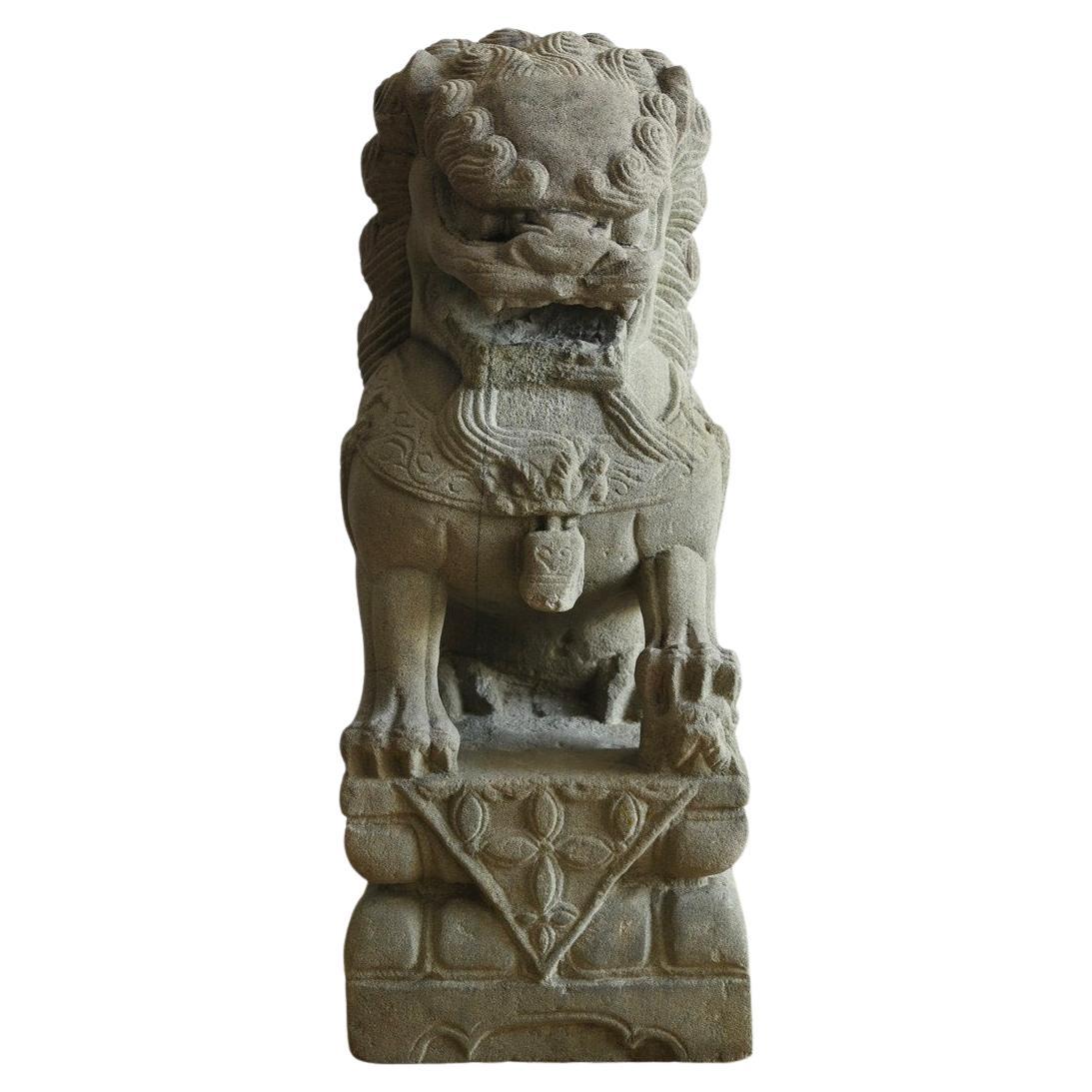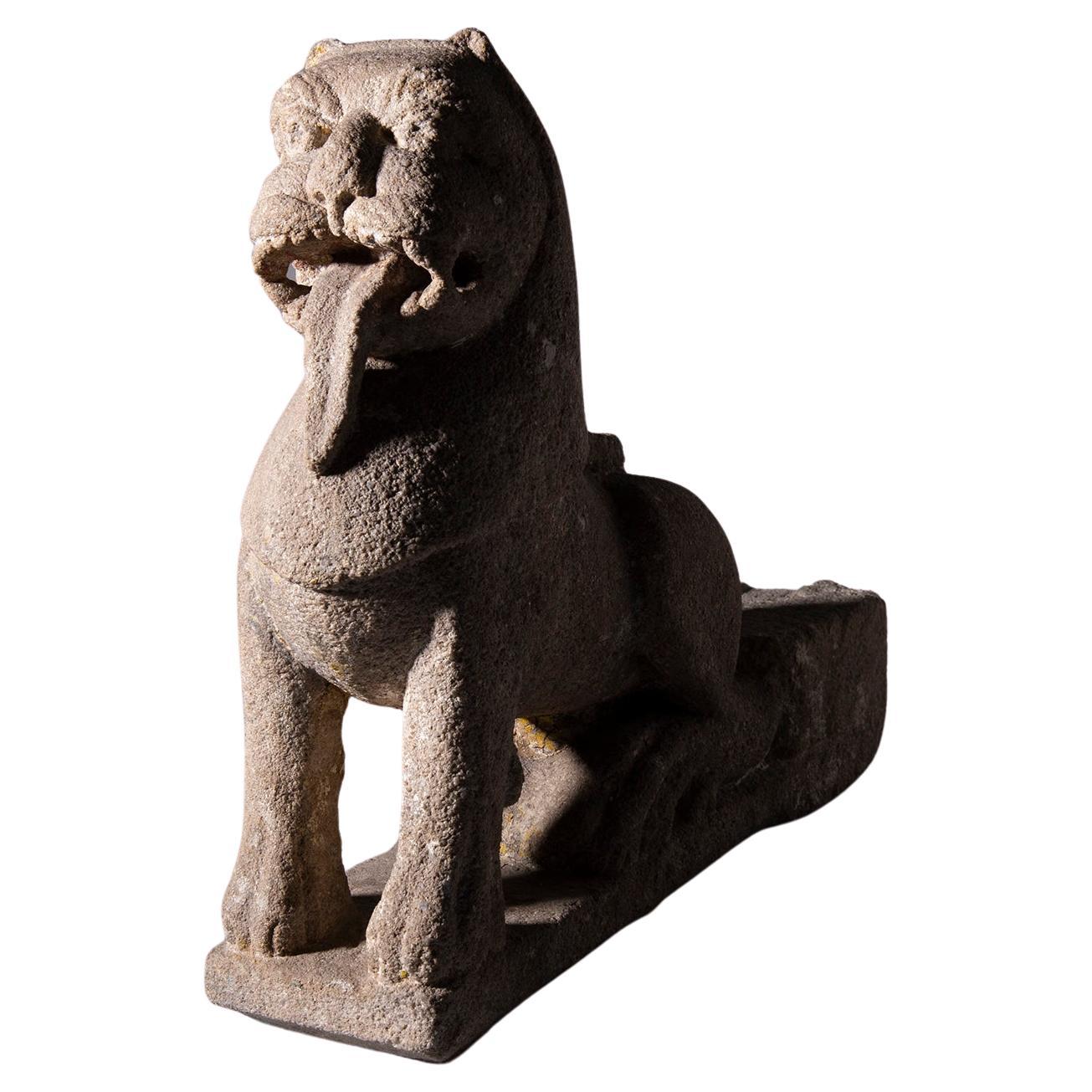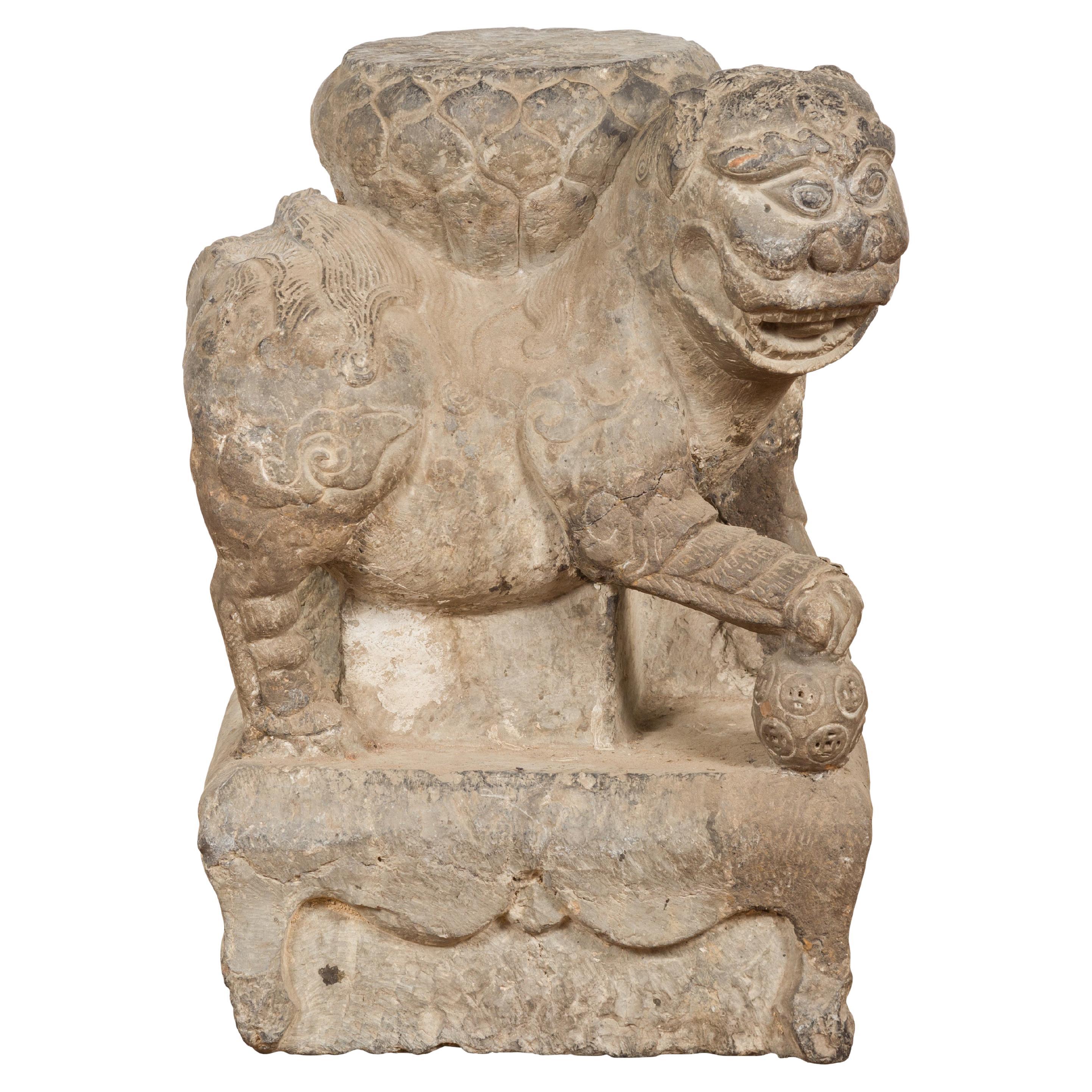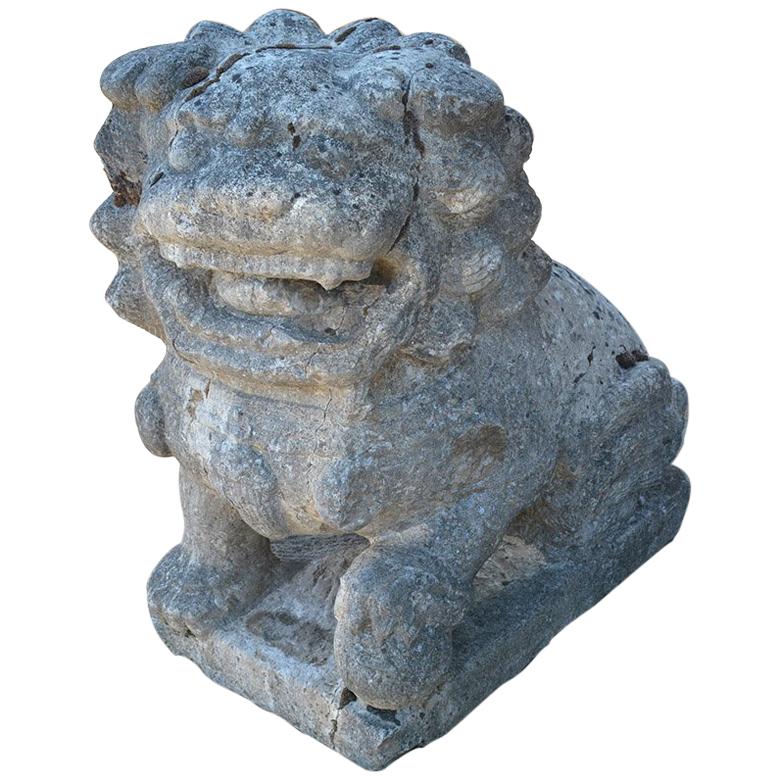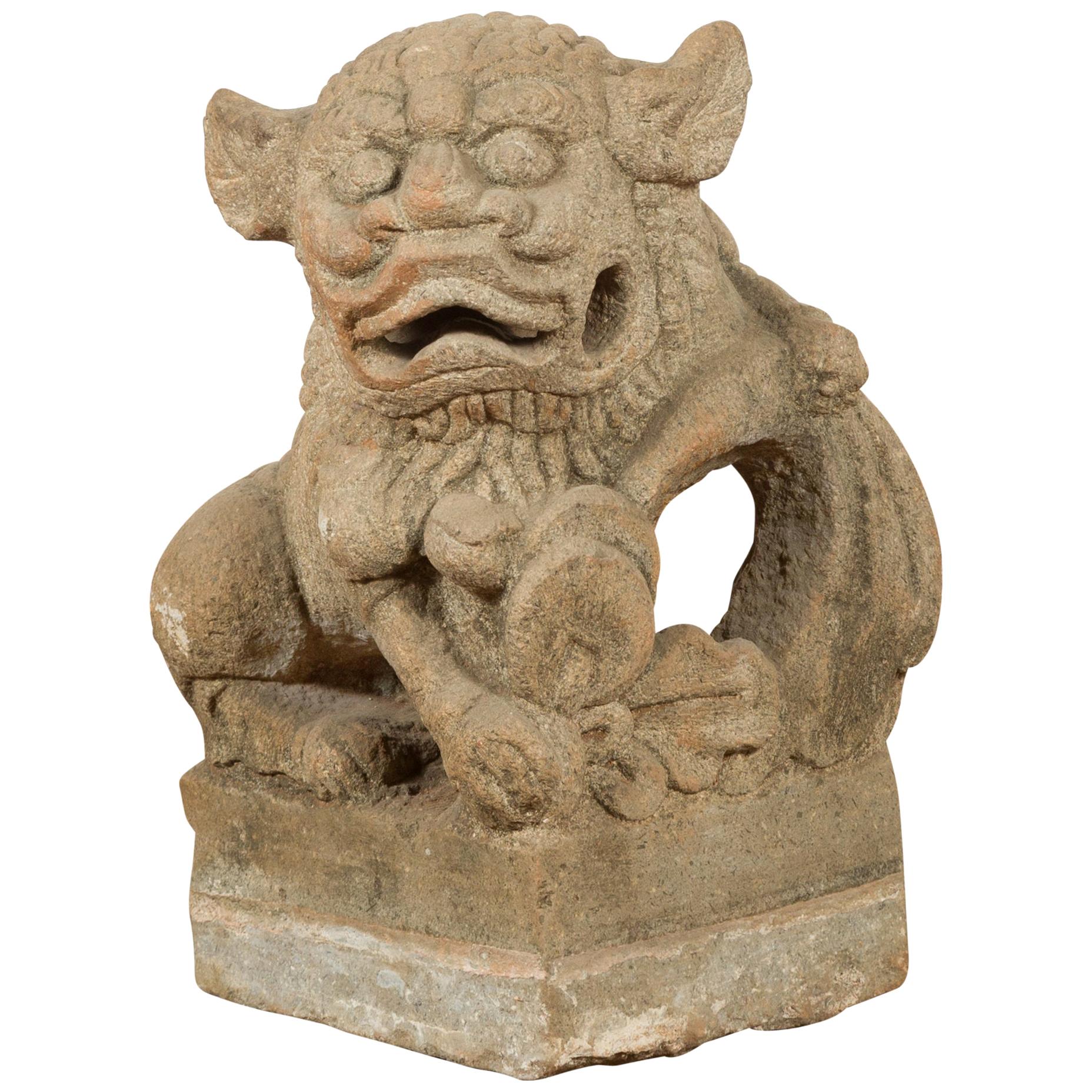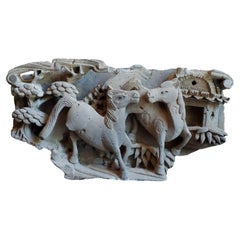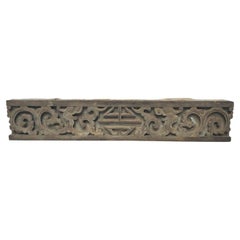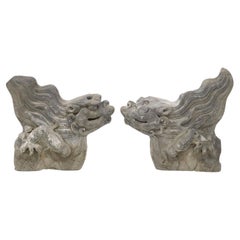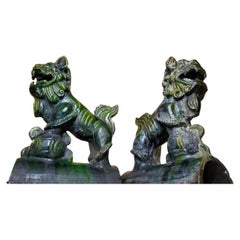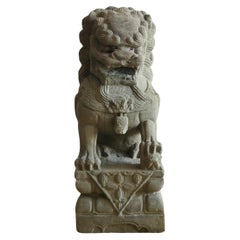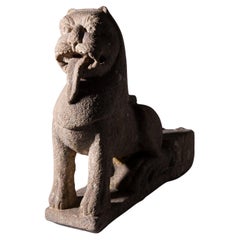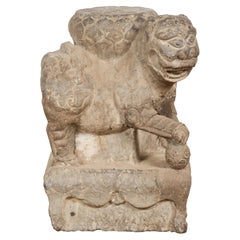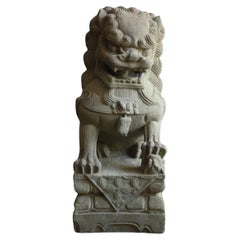Items Similar to Rare Tibetan Buddhist Ancient Temple Snow Lion Architectural Ornament
Want more images or videos?
Request additional images or videos from the seller
1 of 9
Rare Tibetan Buddhist Ancient Temple Snow Lion Architectural Ornament
$9,995
£7,545.44
€8,708.37
CA$14,103.18
A$15,715.63
CHF 8,183.39
MX$189,665.22
NOK 102,597.74
SEK 96,941.67
DKK 65,004.65
About the Item
A magnificent, extremely scarce architectural ornament from a Buddhist temple in Tibet. The solid stone sculpture hand carved from a single large rock, featuring the gankyil energy wheel.
The lion was adopted as a symbol of Shakyamuni Buddha in early Buddhism; it is also depicted as a vehicle for a number of Vajrayana deities such as Vaishravana and Manjushri, and the lion throne may be found in many nirmanakaya Buddha forms. The lion in India art is represented in Tibetan Buddhist art as the Snow Lion. The Snow Lion is the protector of Buddha.
Though paradoxical, the Snow Lion does not fly but their feet never touch the ground; their existence is a playful continuum of leaping from mountain peak to mountain peak. The energetic potency (wisdom or shakti) of the Snow Lion is expressed in the attribute of the gankyil or "ananda-wheel" the Snow Lion keep in eternal play. The gankyil is the principal polyvalent symbol and teaching tool of all the doctrinal trinities of Dzogchen and is the energetic signature of the trikaya. The gankyil is the inner wheel of the Dharmacakra of the Ashtamangala path of Vajrayana Buddhism.
The roar of the Snow Lion embodies the sound of emptiness, courage and truth, and because of this is often a synonym for the Buddhadharma, the Buddha’s teachings, as it implies freedom from karma and the challenging call to awakening. It was considered to be so powerful that just a single roar could cause seven dragons to fall from the sky.
Handcrafted, exceptionally excuted, this ancient temple Snow Lion (Imperial Guardian Lion / Chinese Foo Dog), is an extraordinarily rare and unusual form, having large circular gankyil medallion / orb and scrolling spiral foliate motif to one end, other having large lion holding a small cub in front claws, nicely detailed, with open mouth, exposed teeth and tongue, eyes, nose, claws and mane. Rising on rectangular base, standing at slight tilt. A beautiful and interesting architectural salvaged building element thats decorative, historical and whimsical.
Good proportions. Great for protection at the front door, use as a sculpture, statue or decor around the home, on the patio, in the garden or anywhere you could use luck.
Dimensions (approx):
16.5"h, 18"w, 6.5"d.
- Dimensions:Height: 16.5 in (41.91 cm)Width: 18 in (45.72 cm)Depth: 6.5 in (16.51 cm)
- Style:Tibetan (In the Style Of)
- Materials and Techniques:
- Period:
- Date of Manufacture:18th Century
- Condition:Wear consistent with age and use. Minor losses.
- Seller Location:Forney, TX
- Reference Number:1stDibs: LU5977226088502
About the Seller
4.8
Platinum Seller
Premium sellers with a 4.7+ rating and 24-hour response times
Established in 2013
1stDibs seller since 2021
294 sales on 1stDibs
Typical response time: <1 hour
- ShippingRetrieving quote...Shipping from: Forney, TX
- Return Policy
Authenticity Guarantee
In the unlikely event there’s an issue with an item’s authenticity, contact us within 1 year for a full refund. DetailsMoney-Back Guarantee
If your item is not as described, is damaged in transit, or does not arrive, contact us within 7 days for a full refund. Details24-Hour Cancellation
You have a 24-hour grace period in which to reconsider your purchase, with no questions asked.Vetted Professional Sellers
Our world-class sellers must adhere to strict standards for service and quality, maintaining the integrity of our listings.Price-Match Guarantee
If you find that a seller listed the same item for a lower price elsewhere, we’ll match it.Trusted Global Delivery
Our best-in-class carrier network provides specialized shipping options worldwide, including custom delivery.More From This Seller
View AllAntique Asian Temple Stone Relief Carved Architectural Element
Located in Forney, TX
A magnificent, rare, one of a kind, ancient Asian temple stone architectural panel, likely frieze fragment. Born in Asia, pre-18th century, most likely mu...
Category
Antique 18th Century Asian Ming Religious Items
Materials
Stone
Antique Asian Architectural Relief Carved Stone Frieze Panel
Located in Forney, TX
An exceptional architectural high relief hand carved stone band of running scroll decoration frieze panel, with beautiful scrollwork, representing wind or water, and mythological creature, perhaps a dragon or grotesque griffin. The characters in the center may be Asian hieroglyphs (Japanese kanji). The top side has a dovetail joinery cutout from where it would have attached and fit into place before cementing it in place. 19th century or earlier.
This antique architectural salvage building element is a beautiful and artful display of history, and a quick way to add texture, character, rustic charm and interest. Will make a wonderful decorative object within your home or office.
Provenance:
Personal property of Genshiro Kawamoto. A Japanese real estate billionaire and avid art collector who owned numerous multi-million dollar properties in Hawaii and was building one of the most expensive homes in Hawaii prior to his tax evasion arrest, followed by prison sentence in Japan. He had bought multiple properties to convert into museums in order to display his personal decorative arts collection, but due to his legal and financial problems, his items were all auctioned...
Category
Antique 19th Century Asian Architectural Elements
Materials
Stone
Chinese Ming Dynasty Architectural Terracotta Roof Tile Figure Qilin Foo Dog pr
Located in Forney, TX
A remarkable pair of large Ming Dynasty (1368-1644) earthenware Imperial roof decorations - ornamental architectural terracotta roof tile beasts.
15th/16th century or earlier, Northern China, most likely Forbidden City, Dongcheng District, Beijing, figural pottery modeled as mythical qilin (foo dog / guardian lion), the crouching beast with legs back and flaming body depicted ready to pounce. Retaining partial remnants of the red wax export seal, indicating they are authentic and were legally exported out of the country.
Dimensions: (approx)
Largest: 18" Tall, 19" Wide, 8" Deep
History:
Chinese roof tiles have been a part of Chinese architecture for over 2,000 years. These unique and beautifully crafted tiles have become an integral part of traditional Chinese culture, and have gained international recognition for their beauty and cultural significance. In this article, we will explore the different types of Chinese roof tiles, their construction, cultural significance, preservation and restoration techniques, and modern uses.
Chinese imperial roof decorations or roof charms or roof-figures (Chinese: 檐獸/檐兽; pinyin: yán shòu) or "walking beasts" (Chinese: 走獸/走兽; pinyin: zǒu shòu) or "crouching beasts" (Chinese: 蹲獸/蹲兽; pinyin: Dūn shòu) were statutes placed along the ridge line of official buildings of the Chinese empire. Only official buildings (palaces, government buildings, and some temples) were permitted to use such roof decorations.
Occasionally arranged in an outward marching procession with various different examples, the number and type indicating the importance of the duties performed within the building or within the courtyard protected by a gate. With a maximum number of nine, the mythical beast was one of the highest in rank, thus modeled set to pounce upon the man and lower ranking creatures, ready to devour them should they stray from performing their duties with faithfulness and rectitude
The Design and Construction of Chinese Roofs:
The roof design is an important aspect of Chinese architecture, with each component of the roof playing a specific role. Chinese roof tiles fit into the overall design of the roof and are placed on top of wooden supports called purlins. The interlocking system of Chinese roof tiles ensures that they stay in place and prevent leaks. Ridge tiles...
Category
Antique 16th Century Chinese Ming Sculptures and Carvings
Materials
Earthenware, Terracotta
Antique Qing Dynasty Chinese Glazed Terracotta Guardian Lion Roof Tile Figures
Located in Forney, TX
A remarkable pair of rare antique Qing Dynasty (1636-1912) Chinese terracota architectural roof tile beasts. circa 1900
Hand-crafted in Imperial China around the turn of the late 19...
Category
Early 20th Century Chinese Qing Architectural Elements
Materials
Terracotta
Antique Southeast Asian Temple Strut Architectural Ornament Elephant Carving (2)
Located in Forney, TX
A rare and most interesting pair of two antique Southeast Asian Temple pillar struts / architectural elements.
The hand carved and painted wood figura...
Category
Early 20th Century Southeast Asian Folk Art Sculptures and Carvings
Materials
Wood, Paint
Antique Southeast Asian Burmese Jeweled Carved Qilin Foo Lion Figure Statue Pair
Located in Forney, TX
A near pair of antique Southeast Asian Burmese jeweled parcel gilt wooden temple guardian figure carvings. circa 1900
Hand carved in Burma (present day Myanmar) in the late 19th / early 20th century, most likely the Mandalay region, each richly detailed and gilded, adorned with inset green colored mirrored cut glass mosaic inlays, depicting mythical qilin / stylized lion temple guardian, rising on integral red lacquered platform base,
Dimensions: (approx)
Each: 7" Tall, 2.5" Wide, 4" Deep;
A charming pair of small highly decorative table sculptures / shelf statues...
Category
Early 20th Century Southeast Asian Folk Art Sculptures and Carvings
Materials
Cut Glass, Wood, Giltwood, Lacquer
You May Also Like
Old Chinese stone carved lion typeA /Early 20th century/Garden ornament
Located in Sammu-shi, Chiba
This is a small but very presentable stone lion statue believed to have been made in China. It was probably made in the 20th century, probably after the Republic of China period, and...
Category
Early 20th Century Chinese Chinese Export Statues
Materials
Sandstone
Chinese lion sculpture , WEI DYNASTY PROBABLY
Located in Milano, IT
In the heart of an ancient empire, stands a sculpture of breathtaking power and majesty, probable Wei dynasty. A mighty beast, sculpted from the very essence of strength, is poised i...
Category
Antique 15th Century and Earlier Chinese Qing Animal Sculptures
Materials
Stone
$19,105 Sale Price
20% Off
Ming Dynasty Period Male Foo Dog Guardian Lion Hand-Carved Sculpture
Located in Yonkers, NY
A Chinese Ming Dynasty period (1368 - 1644) hand-carved stone Foo Dog guardian lion sculpture depicting a male placing his paw atop a ball. Created in Ch...
Category
Antique 17th Century Chinese Ming Sculptures and Carvings
Materials
Stone
Old Chinese stone carved lion typeB /Early 20th century/Garden ornament
Located in Sammu-shi, Chiba
This is a stone lion statue made in China, presumably in the 20th century or later, during the Republic of China period. The material used is sandstone, which has a fine and rough te...
Category
Early 20th Century Japanese Chinese Export Statues
Materials
Sandstone
Chinese Carved Stone Garden Guardian Lion
Located in Sheffield, MA
The features of this stone Foo lion has been softened by being exposed to the elements for many centuries. Still a very handsome sculptural specimen made from carved stone, it is kno...
Category
Antique 18th Century Chinese Archaistic Statues
Materials
Stone
Chinese Qing Dynasty 19th Century Carved Stone Foo Dog Guardian Lion Sculpture
Located in Yonkers, NY
A Chinese Qing Dynasty period carved stone foo dog guardian lion from the 19th century, on square base. Created in China during the Qing Dynasty, this st...
Category
Antique 19th Century Chinese Qing Statues
Materials
Stone
